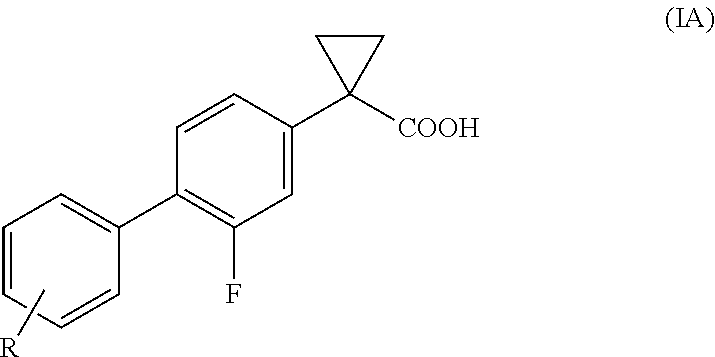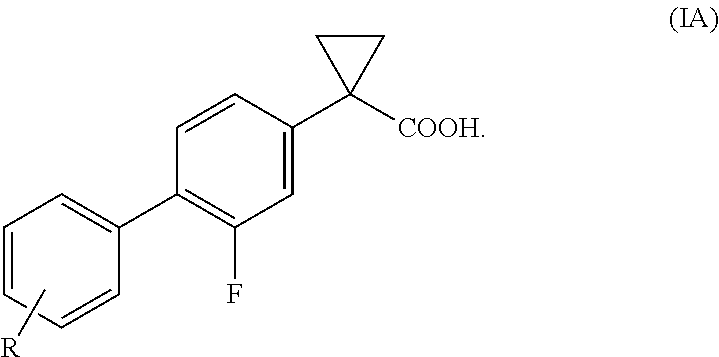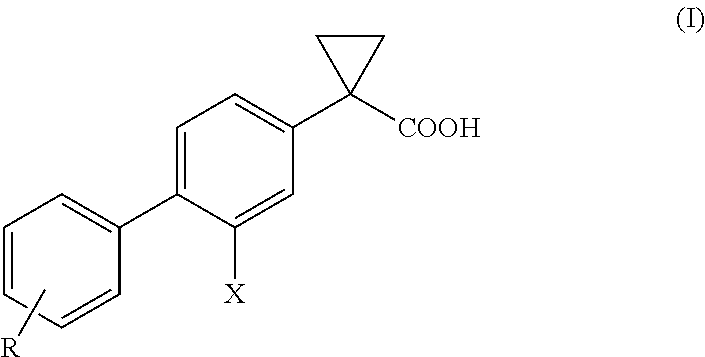Process for the preparation of derivatives of 1-(2- halobiphenyl-4-yl)-cyclopropanecarboxylic acid
a technology of cyclopropanecarboxylic acid and halobiphenyl, which is applied in the field of compound preparation, can solve the problems of low overall yield (12-14%), severe restrictions on industrial use, and poor yield of suzuki coupling reaction, and achieves high chemical purity, high yield of compounds, and high efficiency
- Summary
- Abstract
- Description
- Claims
- Application Information
AI Technical Summary
Benefits of technology
Problems solved by technology
Method used
Image
Examples
example 1
Preparation of 4-bromo-3-fluorobenzyl bromide (III)
[0091]A solution of 4-bromo-3-fluorotoluene (21.5 g, 0.114 moles) in acetonitrile (200 ml) is added with N-bromosuccinimide, (NBS; 21.2 g, 0.119 moles). The mixture is refluxed, added with dibenzoyl peroxide (1.4 g, 0.004 moles), refluxed for 3 hour, then cooled at room temperature, and extracted with water. The aqueous phase is discarded, and the organic phase is washed with brine, dried over sodium sulphate, and concentrated under vacuum to give an oil (27.1 g, 90% yield).
example 2
Preparation of 4-bromo-3-fluorophenylacetonitrile (IV)
[0092]A solution of 4-bromo-3-fluorobenzyl bromide (27 g, 0.1 moles) in ethanol (200 ml) is mixed with NaCN (5.4 g, 0.11 moles) and refluxed for 3 hours. The mixture is concentrated under vacuum; the resulting residue is taken up with water and then extracted with ethyl acetate. The organic phase is washed with brine, dried over sodium sulfate, and concentrated under vacuum to give a dark oil (12.1 g, 56% yield).
example 3
Preparation of 4-bromo-3-fluorophenylcyclopropanenitrile (V)
[0093]A solution of 4-bromo-3-fluorophenylacetonitrile (1 g, 4.6 mmoles) in toluene (4 ml) is mixed with 0.6 ml (7 mmoles) of 1,2-dibromoethane, a 50% NaOH aqueous solution (4 ml), and tetrabutylammonium bromide (0.32 g, 1 mmoles). The mixture is kept under stirring at room temperature for 4 hours, then diluted with water and extracted with ethyl acetate. The organic phase is recovered, and the solvent is eliminated under vacuum to give a brown solid, which is subjected to silica gel chromatography purification, to afford an orange to yellow product in the solid form (1 g, yield 90%).
PUM
| Property | Measurement | Unit |
|---|---|---|
| temperature | aaaaa | aaaaa |
| temperature | aaaaa | aaaaa |
| temperature | aaaaa | aaaaa |
Abstract
Description
Claims
Application Information
 Login to View More
Login to View More - R&D
- Intellectual Property
- Life Sciences
- Materials
- Tech Scout
- Unparalleled Data Quality
- Higher Quality Content
- 60% Fewer Hallucinations
Browse by: Latest US Patents, China's latest patents, Technical Efficacy Thesaurus, Application Domain, Technology Topic, Popular Technical Reports.
© 2025 PatSnap. All rights reserved.Legal|Privacy policy|Modern Slavery Act Transparency Statement|Sitemap|About US| Contact US: help@patsnap.com



